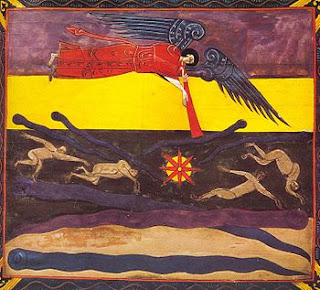A ghost does not have flesh and bones...
The Third Sunday of Easter
Year B
Luke 24:36b-48
for a ghost
does not have flesh
and bones as you see that I have".
Might the story
have been easier to grasp if Jesus had appeared to his disciples as a
disembodied spirit rather than somebody with wounds and an
appetite?
It’s less of a
leap, perhaps, to imagine a ghostly person which is somehow the real person. The ghostly bit lives inside one’s
body for a spell before escaping into the atmosphere or groaning diaphanously in hallways and then disappearing again, floating off to be somewhere better
(or somewhere worse). A default position. It might be
what some of us think will happen to us when we die. Even
the Old Testament has a famous ghost story where Saul and the Witch of Endor
conspire to conjure up the ghost of the prophet Samuel from the depths. Ghosts
are not unknown in the traditions of Israel.
But no - the
Evangelists present Christ as being bodily present in the
midst his disciples. It’s not an easy circle for them to square. On
one hand, in John’s Gospel, Christ bears his wounds and shows them to
Thomas and the other disciples. In Luke, he manipulates bread and wine on
a table and elsewhere he asks his disciples if they have something to eat and,
when given a piece of broiled fish, he digs in. On the other hand,
doesn’t he appear once in a locked room? On another occasion, is he not
taken suddenly from their sight?
He is the same. But
he is different.
The reaction of
his disciples is understandably mixed: “...in their joy they were
disbelieving and still wondering”.
Of what import
this bodily life in the economy of eternity? We both give and receive in our world - in time and space - through the medium of our bodies, our emotions and our voices. We drink in colour and kindness, smells and textures with
these bodies of ours, these brains, these minds and
imaginations. Will we enjoy the warm pong of a smelly Labrador
retriever in heaven? Will we be finished with the combination of
fresh rosemary and lamb chops or those gorgeous cream tarts you can buy warm
from bakeries in Portugal? Will any of these sensual experiences be
a thing anymore?
The earliest
record (earlier than the completed Gospels by decades) are the words of Saint
Paul in 1st Corinthians 15 about both Christ’s resurrection and
our own. With respect to the General Resurrection (of which Christ’s
resurrection is “the first fruits”) he addresses the very question which these
Gospel accounts pose:
But someone will ask, "How are the dead raised?
With what kind of body do they come?"
The
details are beyond any human wisdom, but Paul’s response suggests that what we
sow into the ground (that which undergoes death) is both like and unlike what
God will one day remake for an eternal purpose. What is sown in
death is a seed – more precisely a “naked seed” of what will ultimately become
the full glory of the plant. It retains its lineage with the bodily
life and the recognized identity of people living in their present world
and it is not for nothing that the final chapter of 1st Corinthians
caps an Epistle which has ethics and community life as one of its major themes
- what the Christian does with his or her body in this life – how that body is
expressed faithfully in marriage, how it is presented in equal fellowship with
the bodies belonging to those of different classes, races, languages and
backgrounds. None of these things is wasted – neither our senses nor
our ethics. All of them are important.
We
are now the seed, at least, of what we will become.


